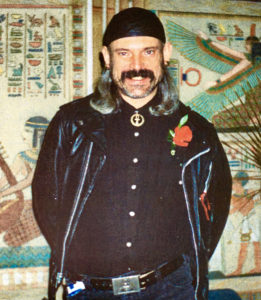
Gay Pride: In The Beginning
written by Jim “Anubis” Chalgren
Akhenaten ruled ancient Egypt from 1377 to 1360 BC, and for a short time ruled with his lover, Smenkhkare. Called the first true individual in history, Akhenaten was also the first historical gay person.
Akhenaten championed a religious revolution that has reverberated through the centuries. Born Amenophis the Fourth, he changed his name to honor his new god: the Aton, the first manifestation of monotheism. The Aton was the first god to be depicted as an abstract force, a sun disc with life-bestowing rays, rather than an animal or human representation.
This faced major opposition from the traditional priesthoods, particularly the powerful priesthood of the Amon. With Akhenaten’s death, the old order was restored. Tutankhaten changed his name to Tutankhamon, honoring Amon. The Aton was eclipsed, but Akhenaten left his mark forever.
Akhenaten’s place in religious history is controversial but perhaps not as controversial as his sexuality. It appears that when Smenkhkare was enthroned, Nefertiti, the famous royal wife of Akhenaten, retired to a palace of her own at the edge of the city. Smenkhkare was given titles formerly held by Nefertiti, including “Beauty of Aton’s Beauties.” Smenkhkare and Akhenaten apparently ruled together openly as lovers.
Cyril Alred, citing a stela of Smenkhkare and Akhenaten, “The intimacy suggested by the latter’s caressing gesture led Newberry to postulate a homoerotic relationship between the rulers, but his suggestion has been rejected by scholars who have found such an idea upsetting…”
The desecrated mummy of mysterious tomb 55 in Valley of the Kings has been generally identified as that of Smenkhkare. An inscription at the base of the coffin reads: “Utterance by [Smenkhkare], deceased, ‘May I breathe the sweet breath that comes forth from thy mouth, may I see thy beauty daily, my prayer is that I might hear thy sweet, breeze like voice, and my limbs be rejuvenated in life through love of thee! Mayest thou extend me thine arms bearing thy spirit that I may receive it and live by it. Mayest thou call on my name for eternity, and it shall never cease from thy mouth. Oh my [defaced] thou being [Akhenaten] forever and ever, living like the Sun-disc [Akhenaten], the King of Upper and Lower Egypt, living in Truth, Lord of the Two Lands [Akhenaten] thou beautiful child of the Sun-disc, who shall be here, living, forever and ever.'”
Another fragment of the coffin identifies the occupant as “beloved of Wa-en-re,” the throne name of Akhenaten. That Akhenaten and Smenkhkare enjoyed an affectionate relationship is not disputed. But the affection shared seems to go far beyond congeniality.
The sun set on “The Great Heretic” and his revolution. His heresy was as a cultural revolutionary, not due to his love for Smenkhkare. Like the sunrise, Akhenaten sheds the first rays of light on a heritage we can be proud of. May we have the courage of heretics and, like the ancient Egyptians, may we have the courage to “Live in Truth.”


